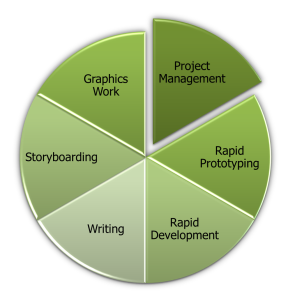3D Tips for the Part-Time eLearning Freelancer July 26, 2011
Posted by kevinthorn in eLearning, eLearning Careers.Tags: eLearning Start Up, entrepreneur, Freelancing, ProfessionalDevelopment
2 comments
 One of the best pieces of advice my father gave me was, “Discover what you’re good at and then learn how to make money at it.” Just like most obedient young boys, I totally ignored my father’s advice.
One of the best pieces of advice my father gave me was, “Discover what you’re good at and then learn how to make money at it.” Just like most obedient young boys, I totally ignored my father’s advice.
Even though I’ve been drawing and cartooning my whole life and developing elearning for the past ten years, I never put the two together. I’m a decent artist but most artists are their own worst critics, and even though I was passionate about it, I never once considered earning a living doing it. That is until I got serious and decided to officially freelance while working a day job.
Some of you may know me through Twitter as @learnnuggets and some of you may know my work through NuggetHead Studioz. I don’t have all the answers, and I don’t have years of experience freelancing let alone freelancing full time to share success strategies. I do have some ‘getting started’ experience and things I’ve learned in the past year that I’ll share what I call my “3D Experience.”
Okay, so you have this thing you’re really good at. You’re really passionate about it and you want a piece of that industry’s pie. What’s next?
Decide
Deliberately deciding is crucial to your success. Think of it like a New Year’s exercise plan. You’re all excited about starting to exercise every day and lose the holiday weight. Off you go and usually within a month the ‘every day’ turns into ‘a couple times a week’ until eventually you don’t have the staying power to continue.

- Commit to a maximum amount of time. You might be willing to put in a lot of hours, but make your maximum a rational and reasonable amount of time that will still keep your family in balance. If you’re like me, it’s also keeping my chores up to par. I decided I could commit to 20 hours a week max. That’s four hours a night with weekends off or three hours a night with some work on the weekend. This plan works for me because I am my family’s night owl. I get quality, evening family time, and then, when my family goes to bed by 9:00pm, I get to work for a few hours.
- Treat it like a job. I treat it like a second job. Many part-time evening jobs are retail or restaurants. They typically close late, and if you’re on the closing shift, you’ll be there another hour or so shutting down. Time is time, and if you’re going to work hard, you might as well work hard for yourself.
Think in terms of cost when deciding the amount of time you’re willing to commit. Go easy on yourself if you’re unsure; say ten hours a week. Remember, you still need to change hats when you go to your day job the next morning, so you want to ensure you’re still getting proper rest – and getting the work done.
Describe
Next, know what is it that you are going to do. Think of your skills and your talents. Describe what you will be doing to yourself before you start telling others. If you don’t know, what makes you think they will know? Definitely, differentiate between practical work and consultation.
- Are you going to be doing the practical application of the work? If so, to what degree? If you’re a designer/developer like me, you have to be honest with yourself about how long it takes to put something together. Whether it’s an illustrated graphic or developing an elearning course, describe the boundaries. I started off with offering the full bucket load from cradle to grave. Everything from instructional design to publishing and LMS support. That’s a lot for a shop of one to handle. I’ve scaled back and focused more on what I do best – design/develop.
- Are you going to be a consultant? If so, to what degree? A consultant brings years of practical application experience to a market where others hire you to help them down a path you once traveled. It’s still time invested but a different kind of time. Lots of phone calls, emails, managing calendars and perhaps even some traveling involved.
Describing what it is you are going to do – and what you’re not going to do – sets boundaries. Not just for your prospective clients, but for yourself. The boundaries will keep you safe from bidding on a project that may be more than you can chew starting out. They’ll also keep the stress at manageable levels.
Deliver
The phrase, “Under promise and over deliver” comes to mind. When you bid on projects, be honest with yourself about what you can deliver. Not so much in terms of the project itself, but how many current projects you have and how many you can balance at one time. I manage anywhere from 4-6 at any given time. Usually I have 3-4 illustration/graphics projects (which take less time), and/or 2-3 elearning projects (which are spaced out in terms of their production). I do this simply because I’m creative, and creative people (me at least) get bored easily. I need multiple projects at one time so I can switch between them often. And often, one project helps solve problems in another.
- Add a minimum of 20% time to every bid. Even if you know without a shadow of a doubt you can make a peanut butter & jelly sandwich in five minutes, bid six minutes. Why? Part time freelance is still life, and the dog is going to run away, your kids will want to play a game, you and your spouse may need to consume an evening talking about something more important. If not the normal stuff, then—even worse—the really crazy will happen. Multiple things will interrupt you. Plan for it.
- Don’t overcharge. It’s very attractive to get all caught up in the world of being your own boss and wanting to make your first million dollars in the first year. Stay humble. Do the work. The rewards will come in due time.
NuggetHead Studioz has only been an official business for less than a year. I have much to learn and only share these thoughts from what I’ve experienced already in that short time. Your situation will be different so just think through it carefully to ensure success. Oh, and of course…just do it!
Top 5 eLearning Skills for 2011 – A Follow-Up March 7, 2011
Posted by kevinthorn in eLearning, Theory.Tags: eLearning Design, InstructionalDesign, Storyboarding, Writing
26 comments
eLearning Weekly welcomes our newest contributor, Kevin Thorn.
Following up on last week’s post titled, “Top 5 Skills for eLearning in 2011,” I’d like to explore this at a different angle. We could go two ways with this: Brand new to the eLearning industry, or a seasoned veteran honing their skills. The comments generated from the original post focused a lot on why Instructional Design was not included in the top 5, so let’s start there with three key points:
- Instructional Design is not eLearning Design. Whether you are formally trained in Instructional Design or you have spent a number of years in the industry practicing the craft, ID is not a specific skill rather a conglomerate of methods, models, practices, theories, and techniques.
- Instructional Design is the “design” of “instruction.” This profession has been around long before eLearning arrived and Instructional Design encompasses everything from classroom instruction to a job aide, while eLearning falls somewhere in the middle.
- Instructional Design is not a single skill but a varying degree of many perishable skills. The eLearning skills you need for 2011 may be directly influenced by the industry in which you work, and therefore some are more prevalent than others.
Let’s begin by suggesting you are either formally trained in ID or you have extensive experience applying the methods surrounding it. From there, what eLearning skills do you need for 2011 – the remaining ten months?
While I don’t necessarily disagree with this first list as each have their merit, but I’m not quite sure these fit as the top 5 skills needed for 2011 as opposed to the next 5-10 years. Let’s look at these 5 again from broader approach and discuss a few more I’ve thrown in.
- Video Production – As Eric pointed out, the cost of producing your own video and the editing software available today is very accessible. However, unless your company is doing an entire video series there really is no reason to spend time learning video production specific skills – this year. Additionally, there are many organizations today that don’t have the proper infrastructure to support video in eLearning. Although any video editing does require patience, it’s not anything a novice can pick up fairly quickly. An affordable HD video cam, Movie Maker (Windows) or iMovie (Mac) can produce quality videos without much effort.
- Social Media – As we all know social media is no longer a trend and is becoming the main stream of communicating. I don’t think SoMe is a skill so much as it is a practice. You gain knowledge of how SoMe works by the mere fact of being embedded in it. Similar to video production where many organizations are not set up to handle that type of media, even more organizations have not incorporated SoMe into their business. Just because there are several really great case studies using SoMe in training, doesn’t mean your organization has a business value to implement it. In preparation for the years to come though, I would encourage everyone to get a Twitter account, join LinkedIn groups, and engage in Facebook Groups, etc. to stay plugged in.
- Mobile Development – I will echo the same thing here…many organizations are not set up to deliver anything mobile let alone mobile learning. Several predictions and forecasting models show mobile (smart phones, tablets, etc.) will be mainstream by 2020 and the keyboard and mouse that we so affectionately love today will be archaic devices. As for gaining skills for mobile development, many eLearning designers & developers do not “code” their courses anymore and use one of the popular authoring tools today. I’ve not hand-coded a course in over 5 years and my guess is we will see tools in the near future that will output mobile designs similar to how authoring tools do today with eLearning.
- Graphic Design – Eric points out here that it’s not so much the skill of becoming a graphic designer, but rather where to find them when you need them as well as making your own. Researching images can be a daunting task, but having relevant research skills along with actually knowing where to go to find them should be foundational. Coming from a graphic design background, I’ve often made the decision to buy (or through CC usage) rather than create myself. In the end, the time it finally took me to search the appropriate images I could have built my own library!
- Rapid Development – First, Rapid Development is NOT a replacement for Rapid Design. The design process must still occur instructionally and visually before any development begins. Every project dictates, but by entering each project with that plan, rapid development is VERY efficient and shaves off hours of work. Two very important considerations need to be addressed here as well: 1) Rapid development is not the cause of poor design, and 2) Rapid Development is authoring tool independent.
More skills:
- Project Management – Consider the entire process from start to finish. You begin with an initial meeting to determine the overall performance outcome. From there you begin your analysis and agree eLearning is the best solution. In the end you have a course/module published on your web or LMS. That entire process is a project. I’ve seen more times than I care to admit where an Instructional Designer is in the middle of an eLearning project and has hit a snag with no clear idea how they got there or how to get out of it. I’m not suggesting run out and earn your PMI certificate, but having fundamental skills in project management methodology is essential.
- Writing – This industry did not exist as a career path when I started. Many people today who work as Instructional Designers earned their ISD or IDT degree. Others came to this industry through circumstance with an English, Journalism, or Technical Writing degree, while others may or may not have any ID or writing background at all. Yet, I suggested that ID is assumed for purposes of this post, one cannot effectively develop eLearning if they do not know how to write content, scripts, or storyboards.
- Storyboarding – Think of the storyboard as the project plan. There is no standard around the exact way to storyboard an eLearning project as each situation dictates. Most I see are sparse and not very useful if someone had to pick up the project on a whim. Think of storyboarding as a project workbook with all documentation supporting the eLearning project.
- Rapid Prototyping – Not to be confused with Rapid Development, this widely unused phase is invaluable. Rapid Prototyping can occur early on in the process and be reviewed for instructional flow and usability. Other aspects such as writing scripts, asset collection, etc. are happening simultaneously.
The days of the workforce training departments with Instructional Designers, Graphic Artists, Developers, etc. is of the past. Today, teams and even individual contributors are the one-all-be-all Training Project Coordinators. This is not an official role, but the title fits more of what the real world is experiencing. One person is responsible for the entire eLearning project from cradle to grave. To be competitive, and more importantly create meaningful and memorable eLearning, one must learn multiple skills.
 There are a multitude of industries deploying eLearning. However, the corporate workforce seems to be where the most attention is needed in getting the right skills in place. With eLearning Weekly’s permission, let’s shake the list up a bit. From the perspective I shared above, two of the original and four additional skills make a new list of the Top 6 eLearning Skills for 2011:
There are a multitude of industries deploying eLearning. However, the corporate workforce seems to be where the most attention is needed in getting the right skills in place. With eLearning Weekly’s permission, let’s shake the list up a bit. From the perspective I shared above, two of the original and four additional skills make a new list of the Top 6 eLearning Skills for 2011:
- Project Management
- Writing
- Storyboarding
- Rapid Prototyping
- Graphics (design or researching skills)
- Rapid Development
What do you think? Are there more/less specific skills for eLearning that we can impress on people to learn or hone this year? Are there timeless skills needed no matter which direction the industry moves this year?


